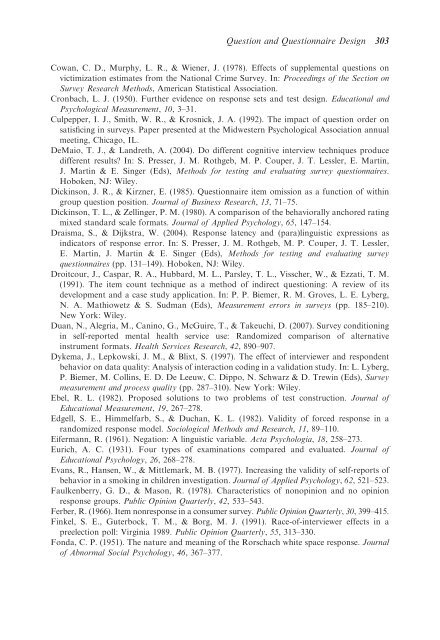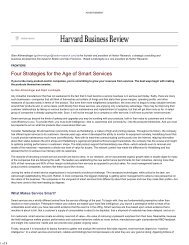Question and Questionnaire Design - Stanford University
Question and Questionnaire Design - Stanford University
Question and Questionnaire Design - Stanford University
You also want an ePaper? Increase the reach of your titles
YUMPU automatically turns print PDFs into web optimized ePapers that Google loves.
<strong>Question</strong> <strong>and</strong> <strong>Question</strong>naire <strong>Design</strong> 303Cowan, C. D., Murphy, L. R., & Wiener, J. (1978). Effects of supplemental questions onvictimization estimates from the National Crime Survey. In: Proceedings of the Section onSurvey Research Methods, American Statistical Association.Cronbach, L. J. (1950). Further evidence on response sets <strong>and</strong> test design. Educational <strong>and</strong>Psychological Measurement, 10, 3–31.Culpepper, I. J., Smith, W. R., & Krosnick, J. A. (1992). The impact of question order onsatisficing in surveys. Paper presented at the Midwestern Psychological Association annualmeeting, Chicago, IL.DeMaio, T. J., & L<strong>and</strong>reth, A. (2004). Do different cognitive interview techniques producedifferent results? In: S. Presser, J. M. Rothgeb, M. P. Couper, J. T. Lessler, E. Martin,J. Martin & E. Singer (Eds), Methods for testing <strong>and</strong> evaluating survey questionnaires.Hoboken, NJ: Wiley.Dickinson, J. R., & Kirzner, E. (1985). <strong>Question</strong>naire item omission as a function of withingroup question position. Journal of Business Research, 13, 71–75.Dickinson, T. L., & Zellinger, P. M. (1980). A comparison of the behaviorally anchored ratingmixed st<strong>and</strong>ard scale formats. Journal of Applied Psychology, 65, 147–154.Draisma, S., & Dijkstra, W. (2004). Response latency <strong>and</strong> (para)linguistic expressions asindicators of response error. In: S. Presser, J. M. Rothgeb, M. P. Couper, J. T. Lessler,E. Martin, J. Martin & E. Singer (Eds), Methods for testing <strong>and</strong> evaluating surveyquestionnaires (pp. 131–149). Hoboken, NJ: Wiley.Droitcour, J., Caspar, R. A., Hubbard, M. L., Parsley, T. L., Visscher, W., & Ezzati, T. M.(1991). The item count technique as a method of indirect questioning: A review of itsdevelopment <strong>and</strong> a case study application. In: P. P. Biemer, R. M. Groves, L. E. Lyberg,N. A. Mathiowetz & S. Sudman (Eds), Measurement errors in surveys (pp. 185–210).New York: Wiley.Duan, N., Alegria, M., Canino, G., McGuire, T., & Takeuchi, D. (2007). Survey conditioningin self-reported mental health service use: R<strong>and</strong>omized comparison of alternativeinstrument formats. Health Services Research, 42, 890–907.Dykema, J., Lepkowski, J. M., & Blixt, S. (1997). The effect of interviewer <strong>and</strong> respondentbehavior on data quality: Analysis of interaction coding in a validation study. In: L. Lyberg,P. Biemer, M. Collins, E. D. De Leeuw, C. Dippo, N. Schwarz & D. Trewin (Eds), Surveymeasurement <strong>and</strong> process quality (pp. 287–310). New York: Wiley.Ebel, R. L. (1982). Proposed solutions to two problems of test construction. Journal ofEducational Measurement, 19, 267–278.Edgell, S. E., Himmelfarb, S., & Duchan, K. L. (1982). Validity of forced response in ar<strong>and</strong>omized response model. Sociological Methods <strong>and</strong> Research, 11, 89–110.Eifermann, R. (1961). Negation: A linguistic variable. Acta Psychologia, 18, 258–273.Eurich, A. C. (1931). Four types of examinations compared <strong>and</strong> evaluated. Journal ofEducational Psychology, 26, 268–278.Evans, R., Hansen, W., & Mittlemark, M. B. (1977). Increasing the validity of self-reports ofbehavior in a smoking in children investigation. Journal of Applied Psychology, 62, 521–523.Faulkenberry, G. D., & Mason, R. (1978). Characteristics of nonopinion <strong>and</strong> no opinionresponse groups. Public Opinion Quarterly, 42, 533–543.Ferber, R. (1966). Item nonresponse in a consumer survey. Public Opinion Quarterly, 30, 399–415.Finkel, S. E., Guterbock, T. M., & Borg, M. J. (1991). Race-of-interviewer effects in apreelection poll: Virginia 1989. Public Opinion Quarterly, 55, 313–330.Fonda, C. P. (1951). The nature <strong>and</strong> meaning of the Rorschach white space response. Journalof Abnormal Social Psychology, 46, 367–377.
















